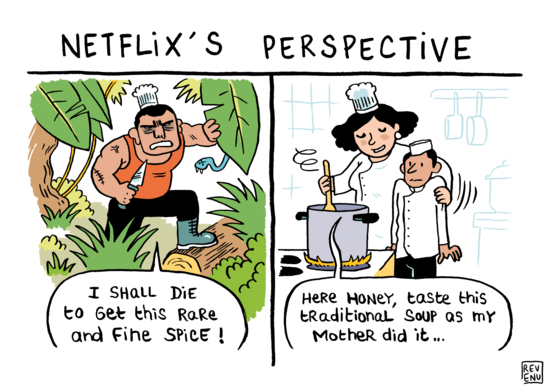Latin America at the Chef’s Table - an analysis of Latin American cuisines representations in Netflix’s series
Download the complete communication (396 Ko)
.
Ana Rosa Santos - PhD student, University of Coimbra/ Assistant Professor, University of Brasília
Aline Macedo Araújo - PhD student, University of Coimbra
Encuentra la versión en español:
Nowadays, the media has a fundamental role in building and mediating tastes and values of social groups, creating and disseminating images and imagery based on which symbolic and material consumption occurs. This work aims to explore how a show can present, perform, interpret, translate, negotiate and/or modify discourses and ideologies that operate through food and cooking – following the categories proposed by Holden (2013) and Swenson (2013). The research focuses on analysing gender and centre-periphery representations present in the 5 episodes of Netflix’s Chef’s Table series starred by Latin American chefs: Argentine Francis Mallmann, Brazilian Alex Atala, Mexican Enrique Olvera, Peruvian Virgilio Martínez and Mexican Cristina Martinez. The series presents and reproduces the inequalities and gendered distinctions in Latin American - and worldwide - professional kitchens, although there are moments of slippage between these inequalities and distinctions. Thus it displays the “nuances of power in food-related activities that reside at the intersections of race, class, sexuality, and migration”, as Julier and Lindenfeld (2005) argue. Among other results, we found out that Chef’s Table reinforces representations such as Latin America related to wilderness and exoticism, and of gender roles that places women in the domestic realm (even in professional settings), while men are presented as dreamers, avant-garde, experts in the fine dining scene. Still, the series has its values and plays an important role in the dissemination of Latin American cuisines. The portrayed chefs seek, through a carefully curated display of their trajectories, to show the vibrant diversity of ingredients and high quality delicacies that Latin America has to offer. They also demonstrate how they managed to value local ingredients, modernize cuisines and amplify environmental and social concerns - now they should continue in the path and modernize labour and social relations as well.
Main references:
Contreras, J., & Gracia, M. (2011). Alimentação, sociedade e cultura. FIOCRUZ.
Counihan, C. (2013). Mexicanas’ Food Voice and Differential Consciousness in the San Luis Valley of Colorado. In Counihan, C., & Van Esterik, P. (Orgs.). Food and culture: A reader (3rd ed). (p.173-186). Routledge.
Holden, T.J.M. (2013). The Overcooked and Underdone: Masculinities in Japanese Food Programming. In Counihan, C., & Van Esterik, P. (Orgs.). Food and culture: A reader (3rd ed). (p.119-136). Routledge.
Julier, A., & Lindenfeld, L. (2005). Mapping men onto the menu: Masculinities and food. Food and Foodways, 13(1–2), 1–16. https://doi.org/10.1080/07409710590915346
Swenson, R. (2013). Domestic Divo? Televised Treatments of Masculinity, Femininity, and Food. In Counihan, C., & Van Esterik, P. (Orgs.). Food and culture: A reader (3rd ed). (p. 137-153). Routledge.

